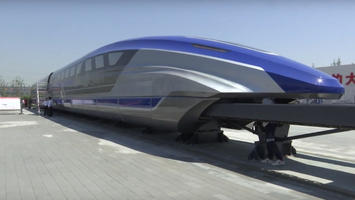
China is building a magnetically levitated (maglev) train that will “fill the gap between high-speed rail and air transportation,” says CNN. This new train may have a top speed of 370 miles per hour, which “could narrow the gap between high-speed rail and air travel,” says Republic World.
What is this preoccupation with gaps? The only gap I see is between the ears of those who think maglev makes sense either in the United States or anywhere else in the world.
Here’s the gap: high-speed rail costs a lot more and goes a lot slower than flying. Maglev will cost even more and still go slower than flying. How does that fix the gap? Wake me up when someone comes up with a technology that costs less and goes faster than jet aircraft.
The truth is that all China has is the shell of a train car. It doesn’t have any tracks (except for the Shanghai Airport maglev that was built for it by the Germans), nor does it have a technology that is known to work.
It appears that China is trying to steal Japan’s thunder, as Japan does have a maglev technology that is supposedly under construction between Tokyo and Nagoya. JR Central (aka JR Tokai), the private company that operates the existing high-speed trains on that route, figured that it could build a faster new line itself without any government assistance.
It turns out it was wrong about that. The latest word is that costs of the project (86 percent of which would be underground) are spiraling upwards and the government is having to provide financial support. The costs were originally projected to be 5.1 trillion yen (about $47 billion), but now have risen to 9.0 trillion ($82 billion), a 75 percent increase. The cost increase, combined with the fact that Japan’s population (and therefore travel demand) is falling, means that JR Central no longer thinks the line will pay for itself.
JR Central, by the way, is also behind the Texas Central plan to build a high-speed rail line between Dallas and Houston. Proponents claim this rail line, like the Tokyo-Nagoya maglev, can be built without government subsidies. More likely is that, like the maglev, they will get people excited and then “discover” they need some government assistance.
With China planning to build maglev lines, Japan will probably consider it a matter of pride to build the Tokyo-Nagoya line no matter what the loss. Meanwhile, the state of Maryland is writing an environmental impact statement for a Baltimore-Washington maglev line. Someone needs to check between Governor Hogan’s ears, as he was elected on a fiscally conservative platform yet somehow allowed himself to be talked into this fiasco in the making.
This piece originally appeared on The Antiplanner.
Randal O’Toole is the director of the Independence Institute’s Transportation Policy Center and author of the recent book, Romance of the Rails: Why the Passenger Trains We Love Are Not the Transportation We Need.
Photo: Via Robb Report.












